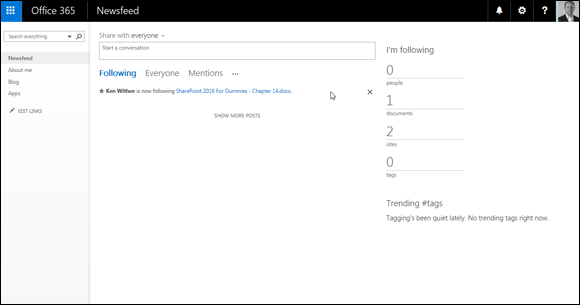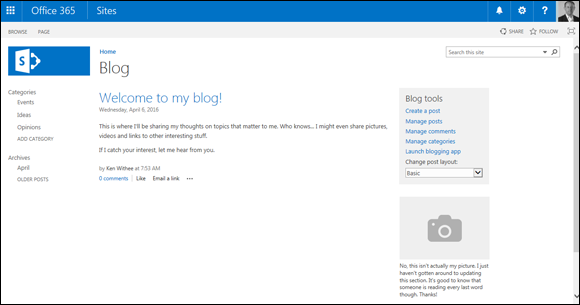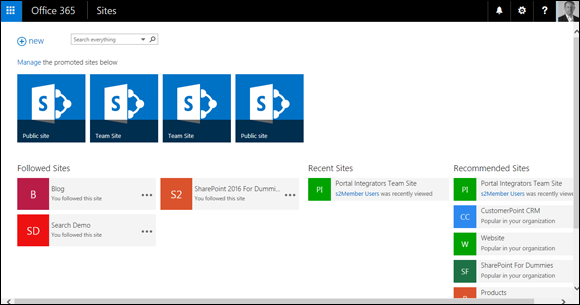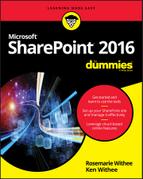Chapter 15
Taking Control of Your Personal Profile and Content
IN THIS CHAPTER
Understanding your personal SharePoint space
Wrangling digital content with OneDrive for Business
Staying up to date with your Newsfeed and blog
Keeping track of your favorite sites
Customizing your SharePoint profile
Throughout this book, you can read about SharePoint sites and how they can be used with teams and organizations. SharePoint also provides individualized benefits designed specifically for you. In particular, you can customize your own individual space and take control of your SharePoint experience.
In this chapter, you explore how your personal SharePoint space works. You find out about some pretty cool apps and explore how to work with these apps using only your web browser. You discover how to aggregate news and create a blog with Newsfeed, sync and organize documents with OneDrive for Business, and add and follow specific sites. Finally, you explore and set up your personal profile.
Organizing Your Personal Content with OneDrive
Your personal cloud storage location, also known as OneDrive, is where you store and organize your documents. You access OneDrive by clicking on the waffle menu (officially called the app launcher) in the upper-left corner of your screen and then choosing OneDrive, as shown in Figure 15-1.

FIGURE 15-1: Accessing your OneDrive site.
When you land on your OneDrive site, the heading OneDrive appears at the top of your browser, and your personal site loads, as shown in Figure 15-2. Congratulations, you are now working in your own personal SharePoint storage location! This is your own personal domain, and everything here is private unless you choose to share it with others.

FIGURE 15-2: The personal SharePoint storage location called OneDrive.
OneDrive includes a number of features right out of the gate that you access in the left-hand navigation tools. You have a Library app in which you can store documents, a view of any recent documents you have worked on, including in other SharePoint sites, a view of documents that are shared with you, and any documents or sites you are following. You also have a recycle bin for anything you deleted that you want to resurrect.
Saving stuff with OneDrive
Your personal storage location, known as OneDrive, is designed as a place to store, organize, and share your documents, such as, for example, a carpool list you’re working on or a potluck spreadsheet. You might also be working on business documents that don’t really fit into any specific app in SharePoint. Your OneDrive is the catch-all place you can store it.
Think of your OneDrive as your personal Documents folder on your computer. The difference is that the personal Documents folder on your computer is only on that single computer. If you’re using a different computer, you can’t access those documents. In addition, if your computer crashes and you have not backed up your Documents folder, then those files are lost. OneDrive is designed to be a secure and safe place to store all your documents. What if your device crashes or is stolen? With your documents stored in OneDrive, you just log in again from a different device and continue working on your documents.
Your OneDrive is designed to live in the cloud and to be accessible by any device you happen to be working on. For example, if you start a document at work and then have to stop working on it when you leave to pick up your kids, you can log in and continue working on the document when you get home. And if you later have to take your mother-in-law to the doctor, and you take your tablet with you, you can log in from your tablet while you’re waiting in the doctor’s office. Finally, if, you drop off your mother-in-law and make a quick stop at the grocery store, and you get an email on your smartphone asking about a detail in the document you have been working on, you can connect to your OneDrive on your smartphone and view the document so you can respond to the inquiry. Being this connected isn’t always the best way to spend your off-time, but OneDrive enables you to decide when and where you want to work. The idea behind OneDrive is that when you need your documents, you can access them as long as you can connect to the Internet.
Creating or uploading documents in your OneDrive
When you first land on your OneDrive page, you are presented with a notice letting you know that OneDrive for Business is a place to store, sync, and share your documents. You can add documents to OneDrive by following these steps:
-
Navigate to your OneDrive page by clicking the OneDrive app in the waffle at the top of the SharePoint window (refer to Figure 15-1).
 If you are using SharePoint Online, then you won’t have any trouble finding OneDrive because Microsoft has already set it up for you. If you are using SharePoint On-Premises, then you will only find the waffle menu and the OneDrive app in the waffle menu if your administrator has set it up for you. If you don’t see the waffle menu, or if you don’t see the OneDrive app in the waffle menu, then contact your administrator to get things set up.
If you are using SharePoint Online, then you won’t have any trouble finding OneDrive because Microsoft has already set it up for you. If you are using SharePoint On-Premises, then you will only find the waffle menu and the OneDrive app in the waffle menu if your administrator has set it up for you. If you don’t see the waffle menu, or if you don’t see the OneDrive app in the waffle menu, then contact your administrator to get things set up. -
Click the New link at the top of the page and select the type of document you want to create, as shown in Figure 15-3.
If you are using SharePoint Online, then you already have the Office document types (Word, Excel, PowerPoint, and OneNote) integrated with your OneDrive site because Microsoft has already set it up for you. If you are using SharePoint On-Premises, then you will only see these document types if they have been set up. If the integration has not been set up, then you will see a dialog box that lets you choose to upload an existing file already.
- The document you created opens and you can add content.
- On the other hand, if you want to upload an existing document, you can click the Upload button instead of the New button (Step 2) and then browse to the document you want to add to OneDrive and click OK to add the file.

FIGURE 15-3: Creating a new document in OneDrive.
You can choose to overwrite the document if a document with the same name already exists. If versioning is turned on, a new version of the document will be created and the existing document will be the previous version. If versioning is turned off, then overwriting will result in the loss of the existing document with the same name.
Aggregating SharePoint Activity with Your Newsfeed
Your Newsfeed is an aggregation of SharePoint activity such as news, mentions, and likes. When you enter the Newsfeed app, you’re presented with a dashboard of your relationships and connections throughout the organization. In addition, you can see which hashtags are trending and how many people, documents, sites, and tags you are following.
To access your Newsfeed, click the waffle icon and choose the Newsfeed app, as shown in Figure 15-4.

FIGURE 15-4: Opening the Newsfeed app.
After the Newsfeed app loads, a dashboard of your SharePoint life appears. Here you find people, documents, sites, and tags you are following as well as places where people have mentioned you in other parts of SharePoint (think of the @name in Twitter or Facebook), and in conversations you are having with people. The Newsfeed landing page is shown in Figure 15-5.

FIGURE 15-5: The Newsfeed landing page.
From the Newsfeed landing page, you can post a status update with everyone or with specific sites for which you have permissions. As people see your post, they can like it or reply to continue the conversation. You see these replies on your Newsfeed page and can thus stay interconnected with your organization in one place without clicking around through each site of every team.
Following a document from another site
A modern organization generates an unbelievable amount of digital content. The sheer number of digital documents can be beyond comprehension. SharePoint is a product that was developed from the beginning to help manage digital content. As each team begins using SharePoint, it can become burdensome to navigate to each site and monitor each document. You might get carpal tunnel from so much clicking! The Newsfeed app pulls together into one nice view all the documents that you are working on, that have been shared with you, or that you are following. Accessing these views can be achieved by clicking the waffle button and choosing the Newsfeed app. To follow a document and add it to the Followed view on your Newsfeed, follow these steps:
- Browse to the Library app that contains the document you want to follow.
-
Click the ellipsis next to the document and click Follow, as shown in Figure 15-6.
A dialog box pops up in the upper-right corner of the screen, letting you know you are now following the document.
- Navigate to your Newsfeed by clicking the waffle and choosing the Newsfeed app.
-
The document you just followed appears front and center under the Following view, as shown in Figure 15-5.
The documents you follow are displayed along with the web address of the document. To the right of the link you can click an X to stop following the document.

FIGURE 15-6: Following a document in a SharePoint site.
Reaching out with a blog
You can share information within your company in many ways. You can send an email, publish a document to your portal, or maybe go old-school and leave a hard copy on everyone’s desk.
But nothing really compares to a good blog. It’s a bit like reading a book with really short chapters. As shown in Figure 15-5, your Newsfeed has a link to your own personal blog. Clicking that link actually does just that — it creates your very own blog site with an entry that lets everyone know to stay tuned to hear from you.
http://portalintegrators.com/my/personal/rosemarie/Blog/
Your blog posts show up on your Newsfeed and the Newsfeed of anyone following you.
As shown in Figure 15-7, your blog site contains some useful links. Notice that you see Categories on the left side and a link to add a new category. You also see an Archives section that shows you past months. This makes is easy for readers of your blog to navigate through and find topics of interest.

FIGURE 15-7: A SharePoint blog site.
On the right side, you have links to the blog tools. Here you can create, edit, and delete posts and manage comments that people make on your blog.
So what is so special about a blog? Nothing, really, except for the content you create in it. Blogging is not for everyone, but if you feel like sharing your thoughts with your colleagues, and you know that you can post at least a few times a month, your blog might be compelling to your coworkers.
Writing in your blog is a great way to communicate what you’re working on, your ideas about the latest company initiative, or what’s going on in your life that you think others may find interesting. The topic of your blog can be about a single thing or can range from the Amazon to Zambia. It doesn’t really matter (unless you start violating some company blogging policies), but what matters to your readers is that you create posts that are interesting to read and you’re updating your blog on a somewhat regular basis.
Tracking Your Favorite Sites
The number of sites being used throughout your organization can be overwhelming. You might be a user on sites for sales, human resources, various departments, carpools, child care, product development, and so on. As SharePoint gains momentum in your organization, the number of sites you might participate in will grow quickly. The Sites app is designed to help you solve this site overload issue. You access the Sites app by clicking the Sites app in the waffle menu. The Sites app loads and a navigation reminder appears at the top of the page that says Sites. This lets you know you are looking at SharePoint sites (as opposed to another app such as OneDrive or Newsfeed which were discussed previously). The Sites app landing page is shown in Figure 15-8.

FIGURE 15-8: The landing page for the Sites app.
To help you keep track of your sites, the Sites app aggregates all the sites you follow. In addition to keeping track of your sites, the Sites app allows you to create new sites and even suggests sites that you might be interested in following based on the sites you currently follow. In other words, the Sites app is a one-stop sites shop and a sites dashboard.
There comes a time when you might want to put together your own site for a particular reason. If your organization has enabled the ability for self-service site creation, then you can create your very own SharePoint site that you and others can use for a particular purpose. For example, you might create a site for everyone carpooling from your neighborhood.
You can create your own SharePoint sites by following these steps:
-
Navigate to the Sites dashboard by clicking the Sites app in the waffle menu (app launcher) at the top-left corner of SharePoint.
Your Sites dashboard is displayed.
-
Click the New button in the top-left corner of the page.
A dialog box pops up, asking for a name for the site and the location where you would like to save the site.
 If you don’t find the New button to create a new site, then you need to request it. This illustrates the point that the SharePoint user interface adds or removes components based on a number of different criteria. For example, in the case of the New site button, your SharePoint farm administrator needs to configure Self-Service Site Creation (SSSC) for the My Site host in order for the New Site button to appear. If you really want to impress your SharePoint administrator, just ask them to go to Application Management in Central Administration. There they will find a link called Manage Web Applications. Then they just click on the My Site host web application and then click the Self-Service Site Creation button in the Ribbon. On the dialog box, they need to select something other than the Be Hidden from Users option in the Start a Site section.
If you don’t find the New button to create a new site, then you need to request it. This illustrates the point that the SharePoint user interface adds or removes components based on a number of different criteria. For example, in the case of the New site button, your SharePoint farm administrator needs to configure Self-Service Site Creation (SSSC) for the My Site host in order for the New Site button to appear. If you really want to impress your SharePoint administrator, just ask them to go to Application Management in Central Administration. There they will find a link called Manage Web Applications. Then they just click on the My Site host web application and then click the Self-Service Site Creation button in the Ribbon. On the dialog box, they need to select something other than the Be Hidden from Users option in the Start a Site section. - Enter a name for the new site and remember the URL that is displayed, as shown in Figure 15-9.
-
Click Create to create the site.
The new site is displayed.

FIGURE 15-9: The Start a New Site dialog box.
Expressing Yourself with Your Profile
In addition to OneDrive, Newsfeed, and Sites you can also configure your personal profile. Your personal profile includes the usual boring data such as your name, phone number, department, title, and manager. In addition, you can upload your picture and enter information about yourself, such as things people should ask you about, your past projects, skills, schools you attended, your birthday, and your interests. Finally, your profile is where you set up your specific language and region information.
People are central to any business, no matter how big or small. Without people, a business wouldn’t run. How people interact with each other creates the culture of a business, and part of that culture is how people figure out who does what job, who knows who, who knows what, and how someone might be able to help you do your job better. That culture, to some extent, can be reflected in SharePoint user profiles, and the better the user profile, the more likely you’re going to get your job done more effectively. And, the more likely others are going to be able to find you easily when they need to.
Creating a holistic profile experience
The first part of creating your profile is to take a look at what properties are there by default. Many of the basic properties come from Active Directory (AD), but depending on how SharePoint was set up, you could also see information from other systems as well. The AD properties that typically show up in user profiles include your name, title, department, manager, and some contact information such as your work phone.
You can update other properties on your profile page, such as About Me, your picture, your location, your home phone, your skills, interests, and projects you’ve worked on in the past. All this extra information creates a much better sense of who you are than just the basic information about who you work for and where you are.
These properties can be edited by clicking your name in the upper-right corner of the screen and selecting About Me. When you’re on your profile page, click the Edit Your Profile link to add in your information.
Filling in your profile information
It seems like practically everyone in the world is familiar with social networking sites such as Facebook, Twitter, and LinkedIn, and Microsoft has taken some cues to extend that social networking functionality into SharePoint. It all starts with sharing some information about yourself so that other people in your organization can find you and read a little about you. That’s where the basic profile information comes into play.
Along with the really basic information that comes from Active Directory (AD), you also see About Me, Picture, and Ask Me About fields when editing your profile, as shown in Figure 15-10. These items are shared with everyone, unlike some of the extra information we cover next.

FIGURE 15-10: Editing basic profile information.
In the Ask Me About section, put in what you’re really good at, work-wise, and things that people might want to know more about you if they knew you had the same interests or a particular knowledge of something they need to know more about. But again, keep it business-related, because this information is shared with everyone.
For your picture, we recommend one of you in business attire rather than the one of you sunburned and on the beach. Remember, the picture you share here shows up in SharePoint, attached to documents you’ve created, or when you show up in search results. A picture is really helpful, for example, if you work in a large organization, and even a small- to medium-sized organization where people don’t work in the same location. Maybe all the employees of your company are so distributed that they don’t all get together but once every year or two, so being able to place a face with a name can help bridge that gap of unfamiliarity. (We’ve been in many situations where the voice doesn’t go at all with the eventual face when we met them in person — a profile picture helps to alleviate some of that awkwardness.)
Filling in the rest of your profile is up to you. One of the cool features of the Contact Information, Details, Newsfeed Settings, and Language and Region sections of your profile is that you can choose who you share that information with. You can choose to share it with everyone or keep it to yourself.

 Your OneDrive files are only secure and backed up if your IT team sets up the infrastructure that way. If you’re using SharePoint Online, then you can be assured that Microsoft is doing this for you. If your local IT team is running SharePoint for you, then check with them to make sure they back up and secure your OneDrive documents.
Your OneDrive files are only secure and backed up if your IT team sets up the infrastructure that way. If you’re using SharePoint Online, then you can be assured that Microsoft is doing this for you. If your local IT team is running SharePoint for you, then check with them to make sure they back up and secure your OneDrive documents. The information you share in the About Me and Ask Me About fields should be what you want people to know about you as it relates to what you do at your company. There’s really no need to share your love of pet rats (unless your business caters to owners of pet rats). Rather, share a little bit about where you came from, what you like to work on, and when you started at the company — keep it simple and useful for others.
The information you share in the About Me and Ask Me About fields should be what you want people to know about you as it relates to what you do at your company. There’s really no need to share your love of pet rats (unless your business caters to owners of pet rats). Rather, share a little bit about where you came from, what you like to work on, and when you started at the company — keep it simple and useful for others.